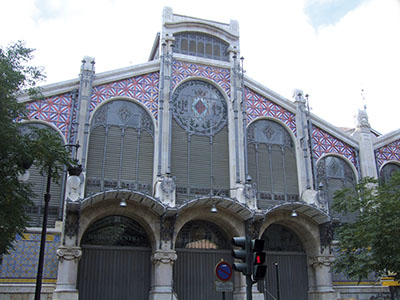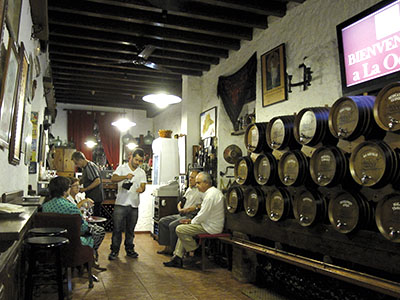Actividad 4
You are now going to listen to a radio documentary about the Mercado Central in Valencia.
Read the following questions. Then listen to the audio track below and answer them in English.
Escucha y contesta.
Transcript: En portada
Now it’s time for another programme in our documentary series En portada. This one is about the market hall in Valencia, El Mercado Central, where the architecture, atmosphere and the quality of the fresh produce makes shopping there a unique experience.
Presentadora Bienvenidos a En portada. En el programa de hoy vamos de compras al Mercado Central de Valencia. ¿Tienen la lista de la compra preparada? ¡Pues vamos!
El Mercado Central está en el centro de Valencia, muy cerca de la Plaza del Ayuntamiento. ¡Es enorme! Es el mercado de productos frescos más grande de toda Europa.
El edificio es precioso: es de principios del siglo XX y su estilo es modernista.
En las calles del Mercado hay puestos donde venden fruta y verdura, pescado y marisco, carne y charcutería, especias, frutos secos, flores…
Vamos a hablar con algunos clientes sobre sus hábitos de compra.
Entrevistadora ¿Dónde hace la compra normalmente?
Entrevistado 1 Compro aquí en el Mercado Central y algunas veces también compro en el supermercado.
Entrevistadora ¿Dónde haces la compra normalmente?
Entrevistada 2 A veces voy a un supermercado, pero la fruta y la verdura la compro siempre aquí.
Entrevistada 3 Bueno, la verdura y la carne en el Mercado.
Entrevistada 4 Normalmente la verdura y la fruta en el Mercado, y el resto en el supermercado.
Presentadora La gente compra aquí porque hay más variedad, los productos son más frescos, y los precios son económicos. Los clientes nos explican por qué vienen al Mercado.
Entrevistado 1 Porque hay más variedad, hay más… está más barato.
Entrevistada 2 Porque hay más donde elegir. Encuentras ofertas…
Entrevistado 5 Las cosas más frescas y mucha más calidad.
Presentadora La región de Valencia es famosa por su huerta, donde se cultivan frutas y verduras de calidad superior, que exporta a todo el mundo.
Muchos vendedores de los puestos del Mercado tienen su huerta y venden los productos que cultivan.
El Mercado simboliza la tradición de la región y también simboliza el progreso: fue el primer mercado del mundo en utilizar internet para vender sus productos. Nos habla una empleada del servicio de atención al cliente.
Entrevistadora ¿Cuál es la dirección de internet?
Empleada Nuestra dirección es www.mercadocentralvalencia.es
Entrevistadora ¿Qué tipo de gente compra por internet?
Empleada Suelen ser empresarios, comerciantes… Gente de treinta a cuarenta años.
Presentadora La compra por internet de productos del Mercado empieza en el año 1996, y funciona muy bien.
A ver, tengo que hacer la compra. ¿Cuál es la dirección? www.mercadocentralvalencia.es. Bien. ¡Huy, qué página web tan bonita!
Historia, puestos, servicios del Mercado, recetas aquí, compra por internet… ¡Aquí está! Tengo que registrarme: nombre, edad… ya está. Bueno, pues la lista de la compra: quiero un kilo de limones, un kilo de tomates, un kilo de peras…
- How big is the market?
- What produce is sold in the market?
- Why do people go to the market instead of the supermarket?
- In what way was the market a world first?
Answer
- It is enormous - the biggest fresh food market in Europe.
- Fruit, vegetables, fish, seafood, meat, charcuterie, spices, nuts, flowers.
- Because there is more variety, the produce is fresher and the prices are cheaper.
- It was the first market to use online ordering.
Skills: Listening to longer extracts
Listening to longer authentic recordings is a good way of building up your listening skills, but you shouldn’t worry if you only catch some of the words or get only a very general idea of what is being talked about. The purpose is to understand the key points rather than every detail. Listen first for the gist before listening for specific information. Remember that you can do this without understanding every word; even when you listen in your own language you will find that you rarely hear every word, unless you are really concentrating on the message (as in airport announcements).
Culture: Shopping in Spain
Although large supermarkets have become more and more prevalent in Spain, many families still do part of their weekly and daily shopping in smaller local shops.
Bread, for example, is something that Spaniards buy daily in the many panaderías that can be found in every town and city. Cakes and pastries, which were traditionally sold in pastelerías, are now commonly sold in panaderías too.
Many people still prefer to buy fresh produce such as fruit and vegetables in the market, whilst meat, fish and cooked meats are often bought in small local independent shops which may offer better quality and service than large supermarkets.
A few bodegas still exist where customers can bring their own bottles or garrafas to buy wine by the litre. Although the expression vino de garrafa is given to cheap, nasty wine, some wine sold in bodegas is very good, and a lot cheaper than bottled wine!
Vocabulario
- la garrafa demijohn, carafe


